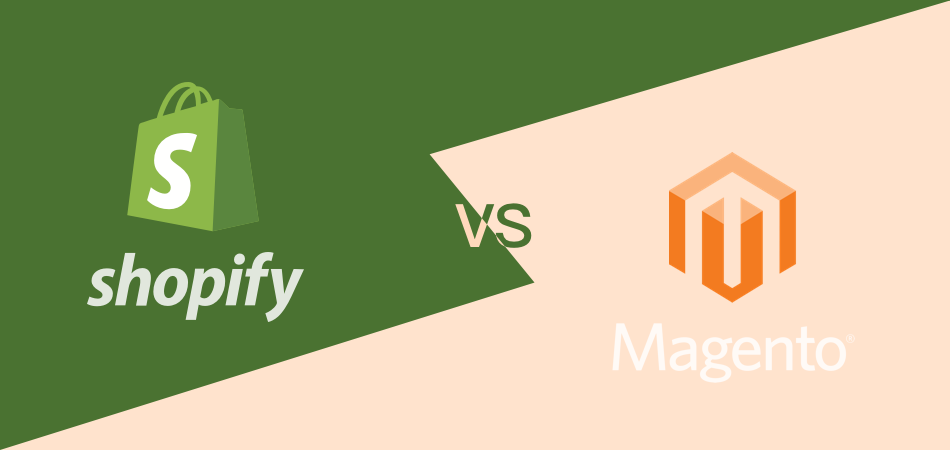Magento vs Shopify: An Ultimate Guide to Find the Top Site to Boost Your Sales in 2022

The most obvious change in the business market is online selling due to the influence of the pandemic in the past year 2020. Most retail activities have shifted from physical stores to online stores.
Maybe now you're operating an online store on Shopify but plan to start one on Magento or you already have one on Magento, while you want to open one on Shopify. However, you are confused about the 2 giant e-commerce platforms. This post will help you better understand them in several aspects:
In this post, I will make a detailed comparison of Magento and Shopify. Based on the comparison, you might be able to make the right decision based on your needs. So just keep reading and get solutions to your questions.
Magento vs Shopify: Overview
Magento and Shopify are both popular for their unique features and services. In this part, I will introduce the basic information of Magento and Shopify. Thus, if you have known the 2 top e-commerce platforms, just skip to the next part.
Shopify
What is Shopify? I can answer it shortly and understandably: Shopify is a user-friendly e-commerce platform and website builder with powerful apps and add-ons, and professional themes.

The best thing about Shopify is that it is a no-code store builder enabling anyone to build their own store. In other words, there are no programming skills required when using Shopify. Plus, you can reach massive impressive integration, such as DSers for AliExpress dropshipping, PageFly for automatically synchronizing pages, and MailChimp for email marketing, with your online Shopify store easily.
| Get Started Now to Grow Your Online Business with the Best AliExpress Dropshipping Tool - DSers! |
Magento
So what is Magento? I have to say, it's a big competitor for Shopify. It is an open-source e-commerce platform. Thus, it requires you to arrange and set up your site hosting. In a nutshell, it gives you more freedom to manage your site.

In June 2020, Magento designed the Magento 2 to replace the past one. This version brings it a wider range of features. I will cover them in the next part one by one. Moreover, Magento 2 supports the latest PHP and is faster in overall front-end performance.
Magento vs Shopify: Features
After reading the above part, you might have got a brief understanding of Magento and Shopify. Next, let's check their features one by one in detail.
1. Ease of Use
If an e-commerce platform is easy to use so that you can take full advantage of it, then it is a good option. The simpler the solution, the more comfortable you will be when experimenting with features.
Shopify makes it incredibly easy to get started and operate your online store. It provides you a 14-day free trial. Once you get started, it'll direct you to an admin dashboard, where all the tools you may need are neatly arranged in easy-to-understand sections.
Moreover, Shopify's drag-and-drop editor allows users to customize their own website according to their own likes and dislikes. Also, they can add and delete modules such as countdowns, images, and text boxes at will.
Magento, asking for code skills to use it, isn't as easy to use as Shopify. It has a clean and sophisticated interface, but requires coding skills to navigate and use effectively. Generally, you need to pay for coding expertise to help design the website with Magento or learn how to code yourself. So using Magento might be time-consuming and costly.
Thus, as you can see, Shopify is simpler to use than Magento.
2. Apps and Add-Ons
Apps and add-ons are crucial factors in building a successful online store.
Here I have to say Shopify's App Store is amazing. It has over 6000 free and paid apps to offer, including integrations with some of the most popular tools in the world, like DSers, the best AliExpress tool. Its app store also includes apps for marketing, customer service, merchandising, and many other aspects of e-commerce. You always only need one click for the installation of these apps.

While Magento has around 4000 extensions to offer in its marketplace, with impressive options for things like payment processing, SEO, and more, you may need some basic coding knowledge to install these apps. What’s more, most of them will cost an extra fee, which will be a problem for entrepreneurs who have a limited budget to sell online.
Thus, the fact is that if you plan to expand the functionality of your store, Shopify app store is more comprehensive than Magento’s.
3. Themes
Both two e-commerce platforms enable you to access various themes, ensuring that you don't have to build your entire site from scratch.
Shopify's theme option is vast, with more than 100+ free and paid designs for you to explore. Using Shopify's intuitive theme editor, you can customize any theme to meet your needs. With the theme editor, you can also add your own content, logos, and product images.

Alternatively, if you prefer, you can skip the theme and design from scratch. With a convenient drag and drop builder on Shopify, you can easily add new elements to your website. It lets you add your own logo, adjust the colors to suit your brand, and modify the appearance of various parts of the site.
Compared to Shopify, the number of themes provided by Magento is fewer. There are only about 16 themes you can explore in total, including free and paid options. About 10 themes are mobile responsive, but you can use code to add responsiveness to other themes.
Although developers can add their own custom themes and update the designs from the backend of their business on Magento, it requires some extensive coding. Worth mentioning here is that Magento also lets you add product sliders to your page, create animations, and include newsletter functionality in your website.
In a nutshell, Shopify has a larger range of themes than Magento. Shopify's themes are also easier to tweak because they don't require you to apply code.
4. Ecommerce Features

Both Shopify and Magento are perfect products to increase your online sales and generate new store opportunities. With your monthly subscription package, you can get a host of e-commerce tools, including:
- Abandoned cart recovery: Help you recover your cart abandonment
- Checkout pages with Shopify Payments: Save transaction fees for your every sale
- Access to multiple payment options: Allow you to use a payment gateway you are familiar with
- Multi-channel selling across social media: Sell your products through channels you prefer
- Partnerships with leading delivery companies: Make your shipment fast and safe
- Upsell, cross-sell, dropshipping and marketing tools: Massive tool options
If there is a need to expand the functionality of your store, you can explore more in the Shopify App market. Shopify has hundreds of tools which are built to improve your chances of earning crucial conversions. Check out these best free Shopify apps, such as DSers, MailChimp, PageFly, Loox, to help grow your online business.
| Get Started Now to Grow Your Online Business with the Best AliExpress Dropshipping Tool - DSers! |
Magento also has a vast range of sales features available. Here, I have to mention its unique inventory system, where you can bulk import information from a database, experiment with multiple product variants, and access total revenue reports. There are also other e-commerce features like:
- Multi-channel selling: Selling options for multiple channels like social media and eBay
- Checkout customization with branding
- Abandoned cart recovery: Help you reduce cart abandonment rate
- Discounts and coupons
- Access to additional extensions
Both two platforms offer tools to help you sell online. However, Shopify has a larger, wider, and more impressive range. Plus, Shopify makes it easy to engage in social media selling, which might be a hassle to do on Magento.
5. Inventory Management
The next aspect is inventory management, which is essential for running a well-organized store. The truth is both Magento and Shopify develop features to help, including product tracking tools, inventory importing, filtering, and categories.
However, Shopify's user-friendly interface takes advantage here. It helps you use your dashboard to examine the product inventory without any hassles. Also, it enables you to customize various form fields for each product, including product name, image, and category.
How about Magento? Magento's inventory management feature is a little different. With it, you can understand better how to label products, including size, color, and quantity. What shines here is that Magento lets you integrate custom extensions for tracking things like offline sales.
6. Marketing Capabilities
Both Magento and Shopify provide you with a vast range of marketing features to boost your chances of sales.
Shopify offers a built-in email tool you can use to promote your products and share updates too. There's also a range of amazing integration you can access through Shopify for things like dropshipping, social media selling, cross-selling.
Magento, however, is a little less advanced from a marketing perspective. On Magento, store owners might need to use apps and extensions to run email campaigns or create social selling strategies. The cost here is the thing that matters again since you'll need a web developer to create more bespoke marketing connections.
Tip: Both Magento and Shopify have access to various SEO tools. They give you the freedom to edit the page title and description on both platforms so that you can improve your chances of ranking higher in search engines.
7. Payment Options
The payment option is among the most significant features that a store owner needs to attach importance to while choosing an e-commerce platform. On Shopify and Magento, your customers can use credit cards or other payment processors to fulfill the payment.
Shopify's, however, has its shining point. Its own payment processor, "Shopify Payments," requires no transaction fees when customers buy from you. Moreover, on Shopify, you can use a payment processor that your customers already feel comfortable with, like PayPal and Amazon Pay.

Although requiring more work to set up, Magento also has its own brilliant payment options. Again, you’d better hire a developer to set up your payment processing system if you aren't familiar with PHP. Unlike Shopify, Magento doesn’t have an integrated payment processor. In other words, you'll need to pay a transaction fee no matter which third-party gateway you adopt for your store.
Overall, while Magento offers a few more ways to accept international payments, Shopify is the better choice for payment processing. Plus, Shopify's integrated payment gateway will help you avoid the transaction fee that you need to pay on Magento.
Magento vs Shopify: Pros and Cons
We have compared the two e-commerce platforms in details. Next, let's have a quick look at their advantages and disadvantages. Let's start with Shopify:
- Multichannel selling: Shopify allows you to sell through multiple channels, like selling on Facebook, Instagram, Amazon, and eBay
- App store: As I mentioned above, Shopify’s app market is brilliant and impressive. These apps help you extend the functionality of your store
- Built-in Tools: The built-in tools help users to use Shopify easily, to run their online business successfully, and market their products quickly
- Beginner-friendly: With the help of built-in tools and guidelines, Shopify is much easier to use than Magento
- Less Control: You have less control over your store operation. If the third-party controller asks you to close your store, you have to do
Then, let's check Magento's pros and cons:
- Large user community: Magento can reach a bigger audience since its Magento Forum has a comprehensive answer for just about anything
- Very flexible platform: Although you need code skills to use Magento, you can design your store free, as long as you know how to code
- Ideal for medium to large businesses: Magento is suitable for businesses with their own web development teams, or a company(business) that have money to spend on hiring a developer
- Unsuitable for beginners: As I mentioned, the platform is not beginner-friendly since it requires code skills to use it
- Hard to install: Unlike other open-source software, Magento has difficulty finding a hosting provider that supports it,(SiteGround is one supporting Magento)
Conclusion
After reading, you can find both Shopify and Magento have highlight features to help you build an online store. Shopify is the better choice if you want to customize your online store in your preference. Plus, Shopify's themes make it easy to create your brand awareness. Most importantly, Shopify provides everything from hosting to online storage and from sales tools, like DSers, to marketing strategies like MailChimp for email marketing, in one package.
However, Magento requires PHP skills to get the ball rolling. The fact is that most small business owners don't have time to learn them. Shopify can reduce the stress of building a custom storefront with its no-code drag-and-drop site builder. If you're just a newcomer in e-commerc













 Company
Company
 Why Choose DSers
Why Choose DSers
 Blog
Blog
 Help Center
Help Center




 Live Chat
Live Chat